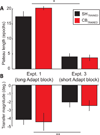Stimulating the cerebellum affects visuomotor adaptation but not intermanual transfer of learning
- PMID: 23625383
- PMCID: PMC3779504
- DOI: 10.1007/s12311-013-0486-7
Stimulating the cerebellum affects visuomotor adaptation but not intermanual transfer of learning
Abstract
When systematic movement errors occur, the brain responds with a systematic change in motor behavior. This type of adaptive motor learning can transfer intermanually; adaptation of movements of the right hand in response to training with a perturbed visual signal (visuomotor adaptation) may carry over to the left hand. While visuomotor adaptation has been studied extensively, it is unclear whether the cerebellum, a structure involved in adaptation, is important for intermanual transfer as well. We addressed this question with three experiments in which subjects reached with their right hands as a 30° visuomotor rotation was introduced. Subjects received anodal or sham transcranial direct current stimulation on the trained (experiment 1) or untrained (experiment 2) hemisphere of the cerebellum, or, for comparison, motor cortex (M1). After the training period, subjects reached with their left hand, without visual feedback, to assess intermanual transfer of learning aftereffects. Stimulation of the right cerebellum caused faster adaptation, but none of the stimulation sites affected transfer. To ascertain whether cerebellar stimulation would increase transfer if subjects learned faster as well as a larger amount, in experiment 3 anodal and sham cerebellar groups experienced a shortened training block such that the anodal group learned more than sham. Despite the difference in adaptation magnitude, transfer was similar across these groups, although smaller than in experiment 1. Our results suggest that intermanual transfer of visuomotor learning does not depend on cerebellar activity and that the number of movements performed at plateau is an important predictor of transfer.
Conflict of interest statement
The authors have no conflicts of interest to disclose.
Figures





References
-
- Lackner JR, DiZio P. Motor control and learning in altered dynamic environments. Curr. Opin. Neurobiol. 2005 Dec;15(6):653–659. - PubMed
-
- Bizzi E, Mussa-Ivaldi FA. Neural basis of motor control and its cognitive implications. Trends Cogn. Sci. (Regul. Ed.) 1998 Mar 1;2(3):97–102. - PubMed
-
- Heuer H, Hegele M. Constraints on visuo-motor adaptation depend on the type of visual feedback during practice. Exp Brain Res. 2008 Feb;185(1):101–110. - PubMed
Publication types
MeSH terms
Grants and funding
LinkOut - more resources
Full Text Sources
Other Literature Sources

